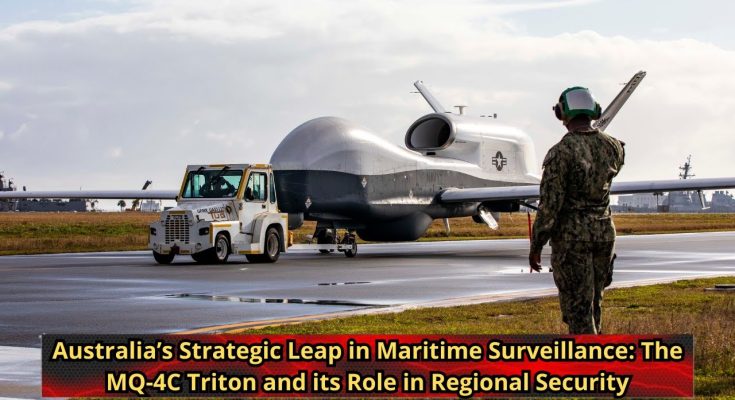Australia has made significant strides in enhancing its maritime surveillance capabilities with the introduction of the MQ-4C Triton, an unmanned aerial vehicle (UAV) designed to provide long-endurance, high-altitude surveillance over vast oceanic areas. As part of its broader defense strategy, Australia’s adoption of the MQ-4C Triton is a key component in strengthening regional security, particularly in the Indo-Pacific, an area of growing geopolitical tension and maritime competition. The Triton’s advanced sensors and extended operational range position it as a critical asset for Australia’s defense forces and its strategic partnerships, especially with the United States.
The MQ-4C Triton: An Overview
The MQ-4C Triton is a high-tech surveillance drone developed by Northrop Grumman, and it is based on the Boeing 747 airframe, optimized for autonomous long-range missions. The Triton is specifically designed for maritime reconnaissance and intelligence gathering, and it can cover vast expanses of oceanic territory, providing crucial data on ship movements, maritime traffic, and other vital oceanographic information. The drone is equipped with an advanced sensor suite, including a multi-function radar system, electro-optical and infrared cameras, and electronic surveillance systems, all of which contribute to its unparalleled maritime monitoring capabilities.
With a wingspan of 39 meters (127 feet) and a maximum altitude of 56,000 feet (17,000 meters), the MQ-4C Triton is capable of staying aloft for over 24 hours. This endurance allows it to monitor expansive regions without the need for frequent refueling, making it an ideal tool for surveillance in vast and remote maritime environments such as Australia’s surrounding waters, as well as the broader Indo-Pacific region.
Australia’s Strategic Requirements
Australia’s defense priorities have evolved in response to growing challenges in the Indo-Pacific, particularly with the rising influence of China in the region and ongoing disputes in the South China Sea. The ability to maintain regional stability and safeguard vital sea lanes for trade and energy transportation is crucial for Australia’s national security and its economic prosperity. Australia’s maritime domain is vast, stretching over 35 million square kilometers, including busy trade routes and strategic chokepoints that are vital to global commerce.
In this context, the MQ-4C Triton plays a vital role in Australia’s strategy to enhance maritime domain awareness (MDA) and improve its intelligence-gathering capabilities. The drone’s ability to provide persistent, real-time surveillance over large maritime areas, including the southern and eastern Pacific, significantly strengthens Australia’s ability to monitor any unusual or potentially hostile maritime activity.
Regional Security and Partnership with the United States
The MQ-4C Triton also enhances Australia’s ability to collaborate with its key defense partner, the United States, in regional security operations. The United States Navy is already operating the Triton, and the two nations share a long-standing defense relationship. The Triton’s interoperability with other U.S. surveillance platforms and its integration into combined military operations enables Australia to work more closely with the U.S. and other allies in countering security challenges in the region.
The presence of the MQ-4C Triton in Australia strengthens the broader security framework of the Indo-Pacific, providing real-time data on maritime movements and regional threats. It plays a particularly significant role in ensuring the safety of international shipping routes and monitoring any maritime incursions or illegal activities, such as unreported fishing or territorial violations. Furthermore, the Triton’s intelligence-gathering capabilities are also invaluable for disaster response efforts, such as monitoring the aftermath of natural disasters in remote areas or conducting search and rescue operations.
Technological and Operational Advantages
One of the key advantages of the MQ-4C Triton over traditional manned aircraft is its ability to cover large areas of oceanic space without putting pilots at risk. The drone’s autonomous flight capabilities allow it to remain in the air for extended periods, ensuring continuous surveillance with minimal downtime. Its sensors provide detailed imagery and intelligence, which can be shared in real time with naval forces, coast guards, and intelligence agencies. This data-driven approach greatly enhances decision-making and allows for more effective responses to maritime threats.
The MQ-4C Triton’s surveillance capabilities are particularly beneficial in Australia’s exclusive economic zone (EEZ), where the country has sovereign rights over marine resources. The drone helps Australia patrol this vast maritime area and ensures that illegal fishing, smuggling, and other illicit activities are detected and intercepted before they escalate.
Conclusion
Australia’s strategic leap with the MQ-4C Triton marks a significant milestone in enhancing the country’s maritime surveillance and defense capabilities. With its advanced technology, long endurance, and high operational range, the Triton is a game-changing asset for monitoring Australia’s maritime domain and contributing to regional security in the Indo-Pacific. By investing in this cutting-edge UAV, Australia not only strengthens its own defense posture but also solidifies its position as a key player in the security architecture of the region, working alongside its allies to maintain stability and protect vital maritime interests.



